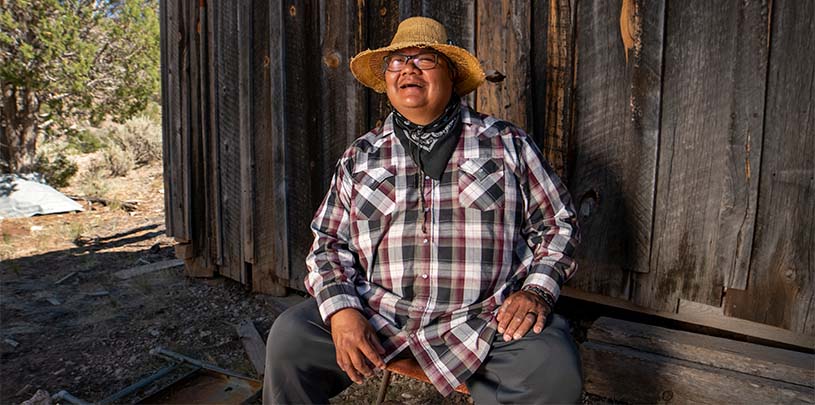
In 2010, Bennett Wakayuta was in between jobs when he got a last-minute invitation to join a river trip through the Grand Canyon. His girlfriend (now wife) worked for the Hualapai Tribe’s health department and had heard that several people backed out of the tribe’s cultural monitoring trip last minute. The cultural department was extending the invitation to anyone who could leave on a two-week river trip with 30 minutes notice.
Wakayuta’s girlfriend said to him, “Grab a pair of shorts, you’re going on a river trip.”
Wakayuta didn’t argue.
“I wasn’t doing nothing. I had a year of sobriety on me,” he said. “So I went.”
From Lees Ferry all the way downriver, Wakayuta soaked in new scenery. He had floated the last 55 miles of the Colorado River, from the Hualapai put-in at Diamond Creek to Pearce Ferry hundreds of times, but this was his first time experiencing the Grand Canyon upstream of the Hualapai reservation through Grand Canyon National Park.
Every day of the trip, they looked at an archaeological site. Sometimes multiple.
“There was a spirit there, and it gave me life. I got more into sobriety. I got more into spirituality, and that’s where I always say I turned full Hualapai.”
The Hualapai reservation starts at river mile 164, but Wakayuta explained that Hualapai people have always been nomadic travelers.
“Our boundaries were us,” he said.
An elder told him on the trip, “Don’t ever think that just because we pass this imaginary boundary, that ‘oh, we’re finally home.’ You’ve been home the whole time you’ve been on the river. Once you touch the water. Everything here — that’s home.”
Reservation boundaries were imposed on the Hualapai, and all other Native American tribes, by the federal government.
“Being displaced, intergenerational trauma, plus the prejudices we’ve had to endure — it kind of shut us down until we were no longer explorers anymore, staying pretty much on our reservation,” Wakayuta said.
But according to Wakayuta, healing has begun and cultural practices are coming back. He said that one of the pilgrimages Hualapai people still make today is to the salt mines below the confluence of the Colorado and Little Colorado rivers.
“Salt was one of our main trade items. For us, it was more precious than gold,” Wakayuta said. “We take the young boys to gather salt at the salt mines, and they give it to elders. These elders are the ones that remember our historical trauma.”
Wakayuta is open about trauma he has experienced in his own life. He was taken from his family when he was 8 years old and placed with a Mormon family in southern California. In his adult life, he was in and out of jail and said people remember him as a “big hell raiser, always breaking things.”
Reconnecting with his Hualapai culture and the canyon helped him work through his anger and abandonment issues, Wakayuta said.
“The connection I felt on the river, that’s what changed my whole life. And it all started off with the water, and then learning these things. I hung on to every word that elders started speaking.”
Besides the salt mines below the confluence, the Little Colorado River is also special to Wakayuta because of the ceremony of water.
“There’s these old Hualapai songs we sing that are specifically for water. When we sing to one tributary of water, that connects to everything,” he said. “We’re not praying for just our area, we’re praying for the world. Everything is connected through that water source.”
The Little Colorado River has cultural and spiritual significance to many of the affiliated Grand Canyon tribes, especially the Hopi Tribe.
“Our connection with the Hopi Tribe has been like brothers forever. If my brother is going to protect something, then I’ll help him protect it. So that’s where my role is for the Little Colorado River, because we need each other.”
Wakayuta said when Hualapai people visit the confluence, like on his first tribal cultural monitoring trip, they like to play around in the turquoise waters.
“We aren’t desecrating. We enjoy life. We enjoy laughter — that’s the only thing we had, in such a traumatic lifestyle throughout generations of our upbringing. We say our prayers and songs before we go play. That’s our respect.”
But on intertribal river trips, in the company of his Hopi and Navajo brothers, Wakayuta said they respect others’ wishes on how to act in sacred spaces. He sees all the tributaries of the Colorado River, including the Little Colorado River as rooms in a house.
“When it comes to visiting these areas, and my brother tells me, ‘be cool, we’re in my room’ then we got to respect that.”
Guest post by Sarana Riggs
Sarana is from Big Mountain, Arizona, and is a member of the Navajo Nation. As an independent consultant, she educates about and advocates for cultural and environmental protections for all Indigenous peoples in the Southwest.
80% of Arizona voters support Baaj Nwaavjo I'tah Kukveni National Monument, according to a new poll.
Read MoreThe Colorado River below Glen Canyon Dam is heating up. Find out why.
Read MoreGroundwater pumping at a uranium mine near the Grand Canyon will affect the canyon's springs, scientists says.
Read More